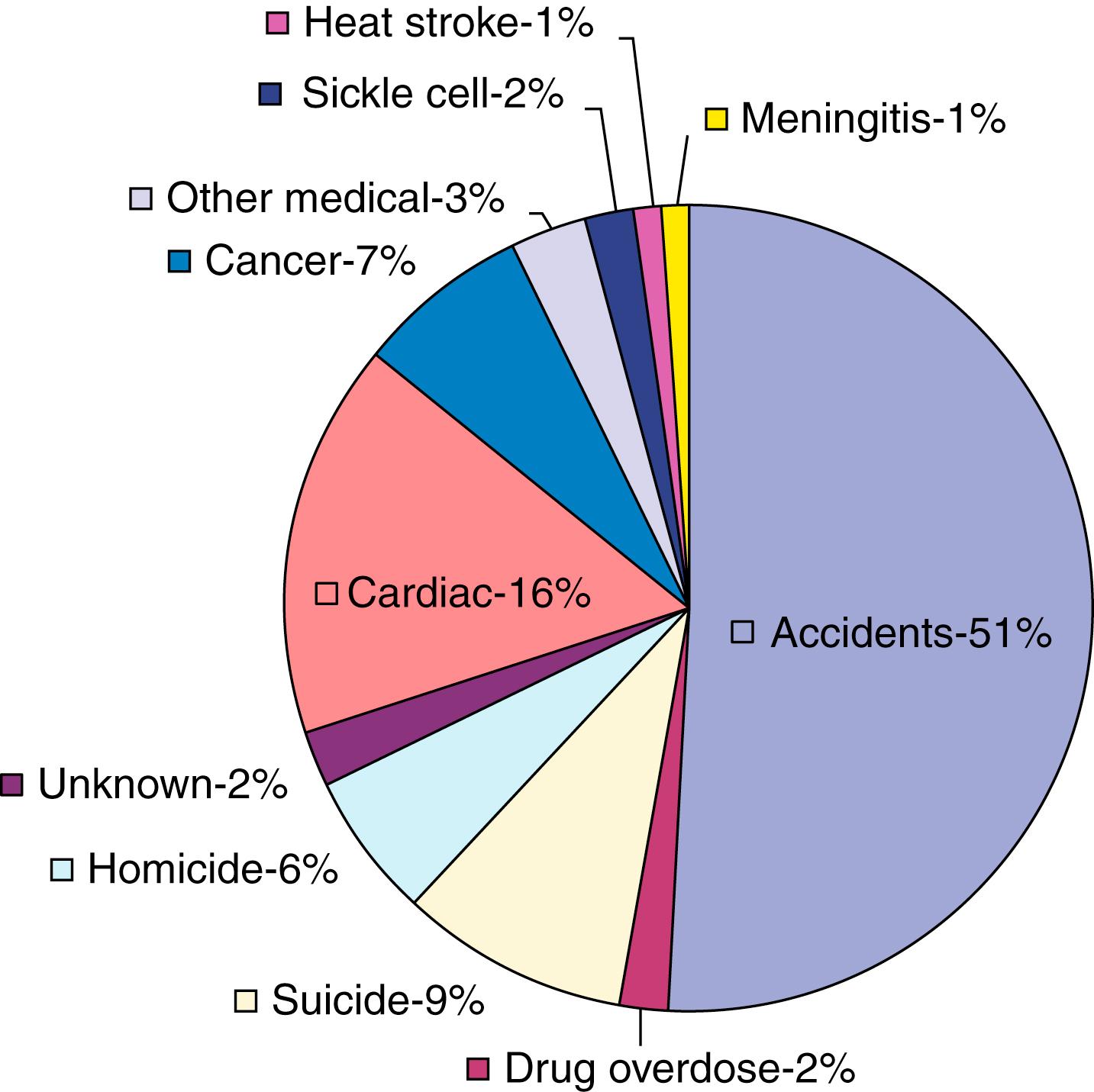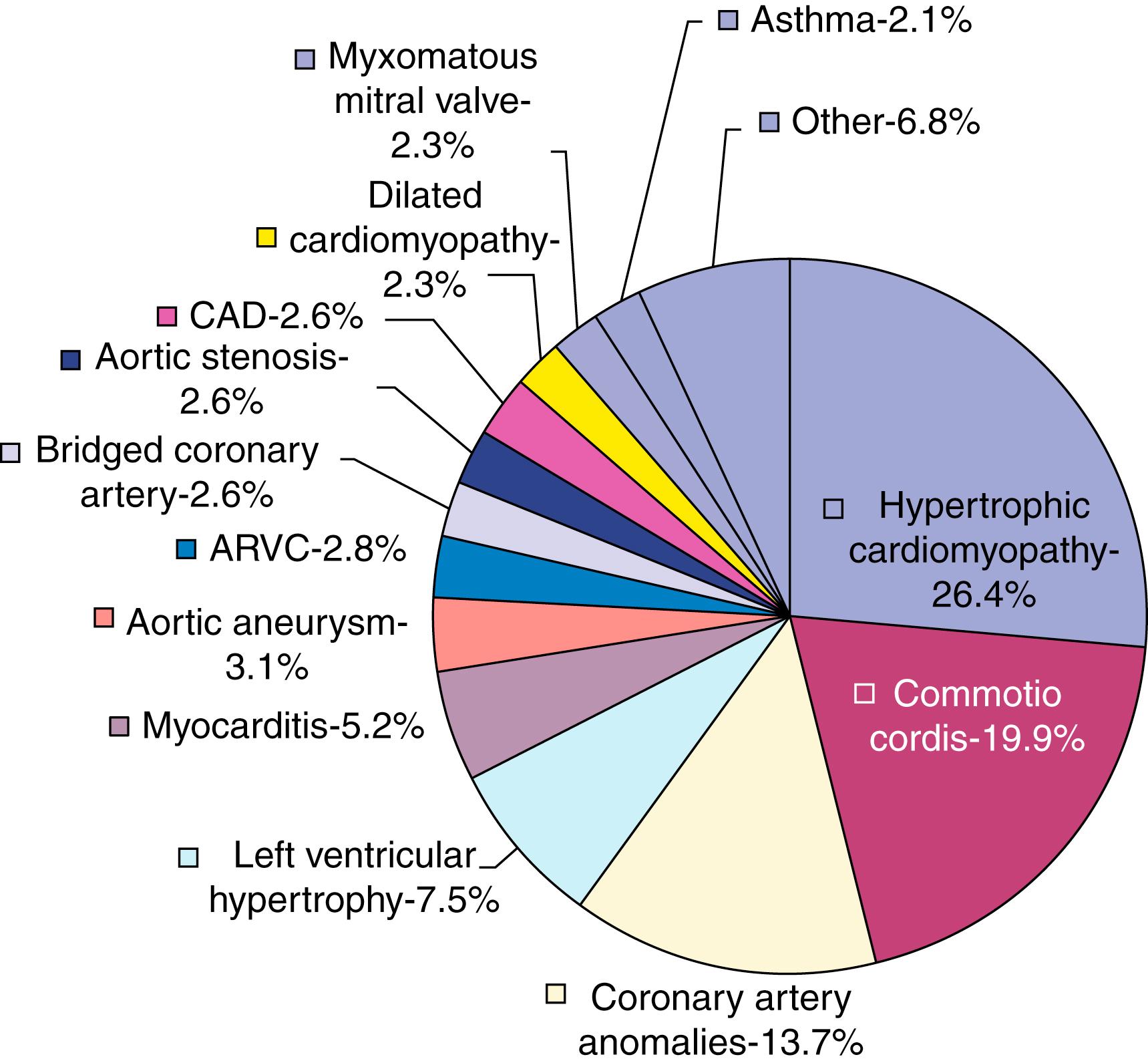Physical Address
304 North Cardinal St.
Dorchester Center, MA 02124
Sudden cardiac death (SCD) in athletes is unusual, but the emotional magnitude is great. Underlying cardiac disease is found in the majority of athletes who die young. Commotio cordis is a cause of SCD unrelated to underlying heart disease. Exercise, and especially extreme exercise, may potentially cause adverse cardiac remodeling, particularly in certain populations. Despite increases in electrocardiogram (ECG) screening, its efficacy in preventing SCD is still unclear. Finally, resuscitation has improved likely secondary to the increased penetration of automated external defibrillators (AED) and cardiopulmonary resuscitation (CPR) training.
In the United States, approximately 150 young athletes die suddenly during sporting activities annually for an incidence of 0.5 per 100,000 athletes a year. , Similar incidences are currently observed in Italy and Canada. , Importantly, athletes dying at home are not generally counted in these data. Because of the often intense media attention that SCD in the athlete generates, there is the appearance that SCD deaths in athletes are much more common than in nonathletes, but that impression is not verified by the available data ( Table 108.1 ). Although there are observational data that basketball players may be at higher risk for SCD (incidence of 3.6 per 100,000 person-years in male basketball players), and that the risk may be perhaps even higher in the National Collegiate Athletic Association (NCAA) Division I male basketball players (1 in 3100 person-years), most data do not support an increased risk for SCD in athletes. , ,
| Country | Reference | Population | Years | Incidence per 100,000 Person-Years |
|---|---|---|---|---|
| Italy | Corrado | Athletes | 1980–1981 | 3.6 |
| Italy | Corrado | Athletes | 2007–2008 | 0.4 |
| Israel | Steinvil | Athletes | 1985–1997 | 2.54 |
| Israel | Steinvil | Athletes | 1998–2009 | 2.66 |
| US | VanCamp | Athletes | 1983–1993 | 0.33 |
| US | Maron | Athletes | 1985–2006 | 0.44 |
| Denmark | Holst | Athletes | 2000–2006 | 1.21 |
| Denmark | Holst | All children | 2000–2006 | 3.76 |
| Japan | Tanaka | All children | 1989–1997 | 1.32 |
| US | Eckart | Military recruits | 1997–2001 | 13 |
| US and Canada | Atkins | All children age 1–11 y | 2005–2007 | 3.73 |
| US and Canada | Atkins | All children age 12–19 y | 2005–2007 | 6.37 |
| Canada | Landry | Sports participants age 12–45 y | 2009–2014 | 0.76 |
| United Kingdom | Malhotra | Soccer players, mean age 16.4 y | 1996–2016 | 6.8 |
| New Zealand | Baggnal | All, 1–35 y | 2010–2012 | 1.3 |
In most series of SCD in the young, deaths outside of sports far exceed deaths in sports. Indeed, in NCAA athletes, deaths unassociated with sports exceed the deaths associated with exertion ( Fig. 108.1 ). In the Resuscitation Outcomes Consortium (ROC), the incidence of sudden cardiac arrests in all children was 3.73 in 100,000 person-years between 1 and 11 years and 6.37 per 100,000 person-years in those between 12 and 19 years. With a US pediatric population of over 74 million (for 2010 Census data, see http://www.census.gov/prod/cen2010/briefs/c2010br-03.pdf ), there are between 3000 and 5000 sudden cardiac arrests per year in the US population between the ages of 1 and 18 years. There are reasonably good data that there are 100 to 150 SCDs in sports. Thus it appears that most SCD in the young occurs outside of athletics.

This lower incidence of SCD in sports has also been seen in Germany and Denmark. In 48,335 fatalities in Hamburg, Germany, only 176 cases involved sporting activities. In 5662 Denmark deaths in individuals between the ages of 12 and 35 years, only 15 were sport related. The incidence of SCD in athletes (1.21 per 100,000 person-years) was lower than that in the general population (3.76 per 100,000 person-years). In a general pediatric population in Japan, the incidence of SCD was 1.32 per 100,000 person-years. In US military recruits, the incidence of SCD was 13 per 100,000 person-years. In a Dutch study, the incidence of cardiac arrest in the population younger than 21 years was 3.2 per 100,000 person-years. Nevertheless, other studies have shown a much higher risk for SCD in athletes. In an NCAA study of athletes, there was a yearly incidence of 2.28 SCD per 100,000, 5 and a UK study of soccer players had a yearly incidence of 6.8 per 100,000. Thus, although most of the available data indicate a similar or lower incidence of SCD in athletes compared with nonathletes, the data are mixed. Available data may be biased because athletic deaths are generally only counted as athletic deaths if they occur on the playing field. Deaths in athletes that occur outside of sports are generally not noted by the media and thus not noted as athletic deaths.
As in nonathletes, the majority of athletes with SCD have an underlying cardiac abnormality ( Fig. 108.2 and Table 108.2 ). In the United States, the most common underlying cardiac condition is hypertrophic cardiomyopathy (HCM; see Chapter 89 ). Coronary artery anomalies, myocarditis, Marfan syndrome, arrhythmogenic right ventricular cardiomyopathy (ARVC; see Chapter 90 ), valvular disease, and dilated cardiomyopathies (see Chapter 87 ) make up most of the remaining underlying heart disease. Commotio cordis, one of the few causes of SCD with a normal heart, accounts for nearly 20% of SCD in athletes when it is included in athletic series, the second most common etiology in the United States. In an Italian series of SCD in athletes, ARVC was found in 22%, whereas HCM was present in 2%. These differences in etiology could be related to the Italian screening process for athletes but also could reflect different genetic penetrations of ARVC and HCM. Anomalous coronary arteries account for a significant percentage of SCD, as does coronary artery disease. More recent studies have shown a much lower incidence of HCM, including 7% in Ontario athletes, 2% in British athletes, and 3% in the NCAA.

| Study | Country | Age (y) | Deaths | HCM | LVH/Possible HM | AN | Commotio | Coronary Anomaly | Myocarditis | Marfan | ARVC | CAD | DCM | LQTS |
|---|---|---|---|---|---|---|---|---|---|---|---|---|---|---|
| Maron (2003) | US | <35 | 387 | 26 | 8 | 20 | 14 | 5 | 3 | 3 | 3 | 2 | 1 | |
| Corrado (2003) | Italy | 12–35 | 55 | 2 | 0 | 7 | 13 | 13 | 22 | 20 | ||||
| Maron (2009) | US | 8–40 | 690 | 36 | 8 | 17 | 6 | 4 | 3 | |||||
| Harmon (2014) | US | 17–24 | 36 | 3 | 11 | 31 | 0 | 14 | 8 | 8 | 3 | 5 | 8 | 3 |
| Finocchiaro (2016) | UK | Mean 29 | 357 | 2 | 16 | 42 | 12 | 5 | 13 | 6 | 2 | |||
| Landry (2017) | Canada | 12–45 | 74 | 7 | 19 | 3 | 7 | 1 | 5 | 38 | 5 | 1 |
Early repolarization has been reported to be associated with SCD. , This is of potential concern for the athletic community because early repolarization is seen in up to 76% of athletes. , Nevertheless, it is apparent that in these studies that report an association with SCD, early repolarization is defined differently than previously. In the studies linking early repolarization to SCD, the abnormalities were defined as terminal slurring of the QRS or early notching of the J wave, unlike previous definitions, which primarily were that of J-point elevation with accompanying ST elevation. The latter definition of early repolarization is very common in trained athletes; however, there have been no data that this early repolarization is a cause of SCD in athletes. In fact, the available data argue that the early repolarization pattern observed in the athlete is not a marker of increased arrhythmic risk.
In nonathletic populations such as the military and general public, the causes of sudden death in the young differ from those in athletic SCD. Genetic cardiomyopathies are much less common, and myocarditis, anomalous coronary arteries, coronary artery disease, and normal hearts are more frequent. , , In nonpediatric populations, underlying coronary artery disease is often found.
Epidemiologic data show the benefit of regular exercise in the prevention of CAD and the reduction of mortality. The reduction in cardiovascular events is secondary to a number of beneficial effects of exercise including decreased weight and blood pressure and improved lipid and glucose tolerance. This reduced risk for cardiac events is seen with chronic energy expenditure as minimal as walking and appears to increase with both the time and intensity of exercise. , In general the more vigorous the exercise, the greater the long-term benefits. It has been argued that low cardiovascular fitness constitutes the largest attributable risk for all-cause mortality. , American Heart Association (AHA) physical activity guidelines call for 30 minutes of moderate intensity aerobic activity 5 days a week or vigorous intensity aerobic activity 3 days a week. In addition to a reduction in physical disease, there is also evidence that sport participation, including but not restricted to competitive sports, reduces the risk for suicide, an especially important consideration for the young in whom suicide is the third leading cause of death. ,
Whether the benefits of exercise extend to those with underlying heart disease is not as clear. Certainly there is evidence for those with CAD that exercise is beneficial. For ARVC, however, there is convincing evidence that vigorous exercise is harmful. Although there has been general concern about exercise in HCM, the data do not yet show an increased risk. , Similarly, for those with LQTS, there is no signal for harm.
Become a Clinical Tree membership for Full access and enjoy Unlimited articles
If you are a member. Log in here